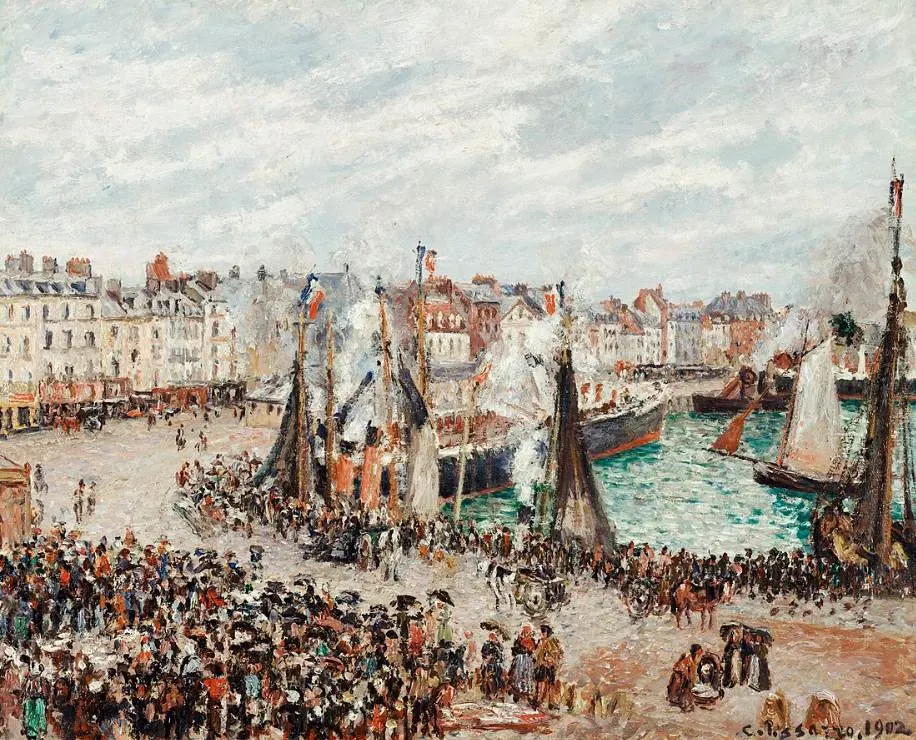This renowned and influential French artist was born on the island of Saint Thomas, a US Virgin Island that was part of the Danish West Indies in the early 1830s.
Camille Pissarro (1830-1903) was one of the leading Impressionist artists of the 19th century who also briefly dabbled in Neo-Impressionism during the 1880s.
He’s certainly equally important as Claude Monet (1840-1926) in the development of Impressionism and was considered to be a father figure to young aspiring artists.
This wasn’t merely because he was the oldest member of the group. Nor was it because he was the only artist to exhibit his works during all 8 Impressionist Exhibitions in Paris between 1874 and 1886.
He was the silent leader of the group who kept his Impressionist paintings simple and sincere, characteristics that reflected his personality as well.
In this article, you’ll discover some of the most famous paintings by Camille Pissarro so you can learn all about this remarkable artist.
1. The Boulevard Montmartre at Night
- Date created: 1897
- Dimensions: 53.5 x 65 centimeters (21 x 25.5 inches)
- Location: National Gallery, London, United Kingdom
The Boulevard Montmartre at Night is one of the 14 paintings by Camille Pissarro that depict the Boulevard Montmartre in Paris. This was a period in his life when he struggled to paint outdoors because of an eye infection and he to solve this issue he produced paintings from a hotel window.
This painting is the most remarkable one in this series because it’s the only one that he ever completed depicting a scene at night. The way he included the artificial lights of this large boulevard in the northern part of Paris transforms the scene into a vibrant cityscape unlike any other painting ever created.

2. Jalais Hill, Pontoise
- Date created: 1867
- Dimensions: 87 x 114.9 centimeters (34.3 × 45.2 inches)
- Location: MET Museum, New York City, United States
Jalais Hill, Pontoise is the title of a painting by Pissarro that depicts a small hill in Pontoise, a rural community just northwest of Paris. It was completed in 1867 and displayed at the prestigious Paris Salon of 1868 to much critical acclaim.

This was a period in Pissarro’s career when he was influenced by renowned French landscape painter Camille Corot (1796-1875). Corot managed to capture the French landscape remarkably and this painting firmly established Pissarro as a famous landscape painter himself.

3. Hay Harvest at Éragny
- Date created: 1901
- Dimensions: 53.9 × 64.7 centimeters (21.2 x 25.5 in)
- Location: National Gallery of Canada, Ottawa, Canada
Hay Harvest at Éragny is arguably one of the artist’s most stunning paintings. It depicts the hay harvest in the small French town of Éragny-sur-Epte in northern France. We see several female farmers who casually harvest hay in this rural village.
Camille Pissarro had moved to Éragny-sur-Epte from his former home of Pointoise in 1884. He lived here together with his wife Julie Vellay for the rest of his life. The rural landscape of this area in France provided the artist with an abundance of subject matter.
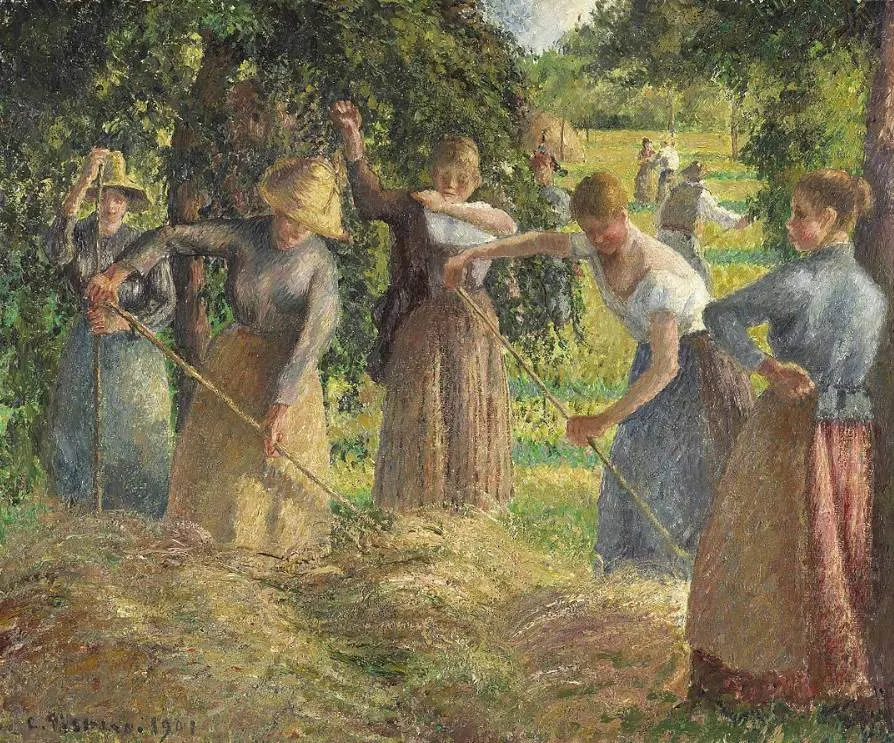
4. The Harvest, Pontoise
- Date created: 1881
- Dimensions: 46 cm × 55.2 centimeters (18 × 21.7 inches)
- Location: MET Museum, New York City, United States
The Harvest, Pontoise is a very similar painting to the work he completed two decades later in Éragny-sur-Epte. It depicts a group of farmers during the harvesting in Pontoise, the other small village where he lived just northwest of Paris.
Today, this rural community has been absorbed by the expanding city of Paris and is pretty much a suburb of the French capital. Unlike the female hay harvesters, this group of French farmers is gathering potatoes.
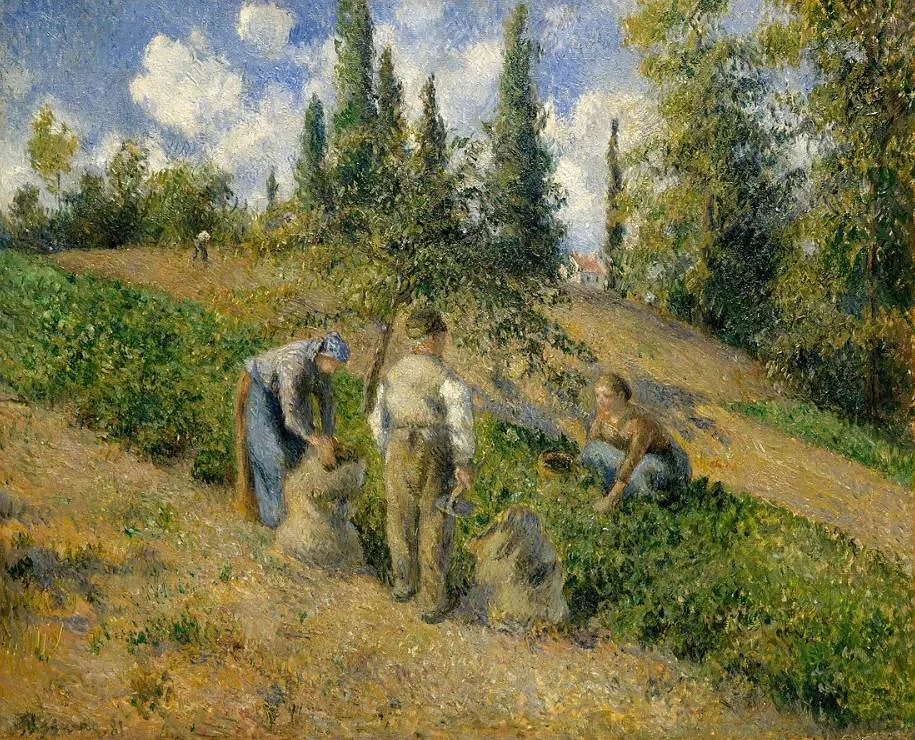
5. Road to Versailles at Louveciennes
- Date created: 1869
- Dimensions: 38.4 x 46.3 centimeters (15.1 x 18.2 inches)
- Location: Walters Art Museum, Baltimore, United States
Road to Versailles at Louveciennes is a painting that Camille Pissarro completed in 1869, the year that he moved to Louveciennes. This was yet another small village where Pissarro lived for a period which is also located in the Yvelines department in the western suburbs of Paris.
More importantly, this village is located just a few kilometers north of Versailles, the location of the immense Palace of Versailles which is located just outside of Paris. Pissarro depicted the road leading to Versailles on various occasions, including during the Winter months as seen in this painting.

6. Pont Boieldieu in Rouen, Rainy Weather
- Date created: 1896
- Dimensions: 73.6 × 91.4 centimeters (29 × 36 inches)
- Location: Art Gallery of Ontario, Toronto, Canada
Pont Boieldieu in Rouen, Rainy Weather is another painting that Camille Pissarro completed during the final period of his life. He didn’t limit himself to hotels in Paris as he also visited other cities in which he painted the scenery from an elevated hotel window.
He already visited the city of Rouen in the early 1880s and produced a series of paintings during this time. This work was completed in 1896 and was one of the first true Impressionist paintings he completed after experimenting with the Pointillist technique.

7. La Récolte des Foins, Éragny
- Date created: 1887
- Dimensions: 50 x 66 centimeters (19.6 x 25.9 inches)
- Location: Van Gogh Museum, Amsterdam, Netherlands
La Récolte des Foins, Éragny is considered to be one of the greatest examples of Pointillism in the oeuvre of Camille Pissarro. He studied this technique together with Georges Seurat (1859-1891), the French artist who perfect the technique that he invented in the early 1880s.
Pissarro completed this work by painting small dots and lines which produce larger fields of contrasting colors to complete the entire composition. This painting was once owned by Theo van Gogh, the brother of Vincent van Gogh (1853-1890), the Dutch artist who greatly admired Pissarro’s work.
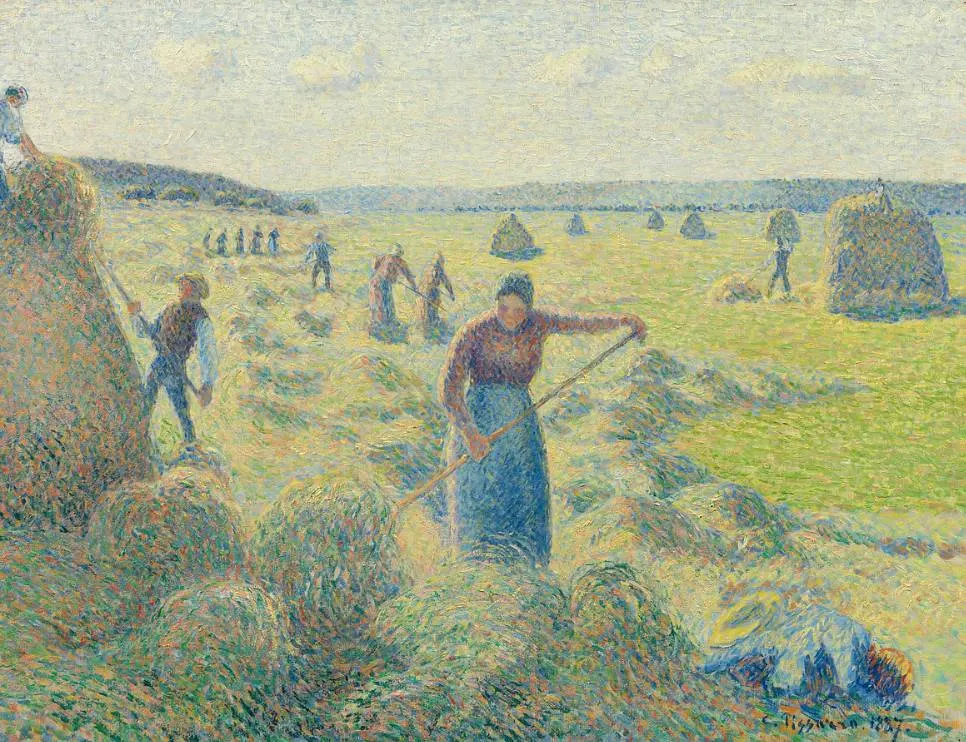
8. Place du Théâtre Français, Paris, Rain
- Date created: 1898
- Dimensions: 73.6 x 91.4 centimeters (29 x 36 inches)
- Location: Minneapolis Institute of Art, Minneapolis, United States
Place du Théâtre Français, Paris, Rain is the title of another painting that Pissarro produced while he was working from a Parisian hotel room. This work depicts the scene on a rainy day in Paris and is a remarkable work that shows life in Paris in the late 19th century.
The painting depicts a view down the Avenue de l’Opera, a large thoroughfare in the heart of Paris that leads from the northwestern corner of the Louvre Museum to the magnificent Palais Garnier, the home of the Paris Opera. You can see the dome of the opera house at the end of the avenue.

9. The Garden of the Tuileries on a Spring Afternoon
- Date created: 1899
- Dimensions: 73.3 cm (28.8 in); width: 92.1 cm (28.8 x 36.2 inches)
- Location: MET Museum, New York City, United States
The Garden of the Tuileries on a Spring Afternoon is a painting that Pissarro completed the year after he spent some time at the Avenue de l’Opera. He had moved to an apartment at 204 rue de Rivoli which was situated right across from the Tuileries Garden, the large landscaped park west of the Louvre.
This apartment provided an excellent view of the park and Pissarro completed several versions at different times of the year. He completed 6 views of the garden and 8 views depicting the side of the Louvre museum/ The two towers in the distance of this work are the Gothic Revival steeples of the Basilica of Saint Clotilde.
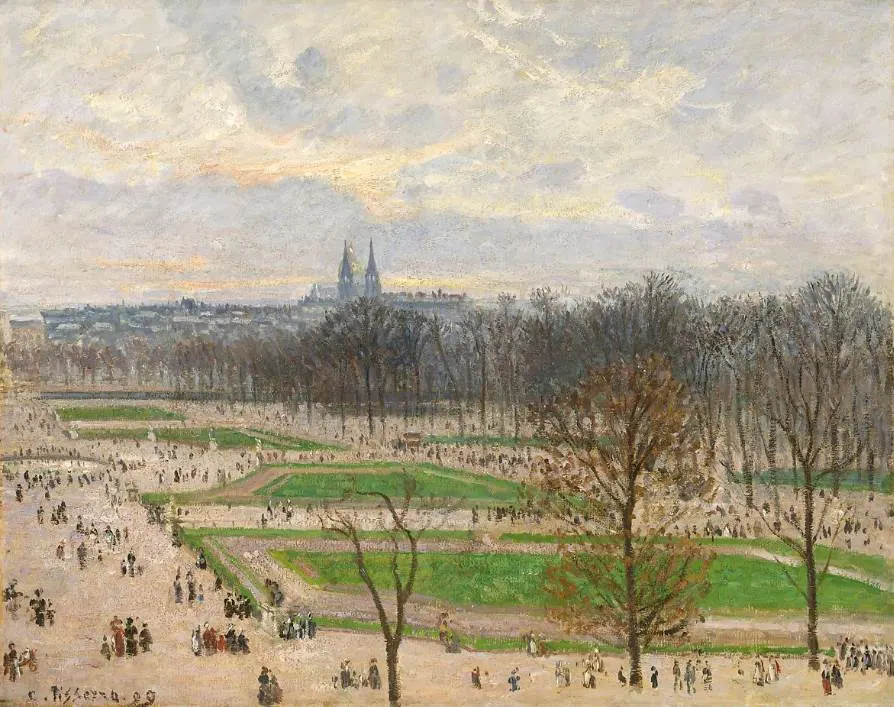
10. The Fish Market, Dieppe: Grey Weather, Morning
- Date created: 1902
- Dimensions: 65.4 x 80.9 centimeters (25.7 x 31.8 inches)
- Location: Dallas Museum of Art, Dallas, United States
The Fish Market, Dieppe: Grey Weather, Morning is the title of a painting that depicts the fish market in the commercial harbor of Dieppe. This coastal town is located in the Normandy region of France in the northern part of the country.
This painting depicts the view that Pissarro had from the third-floor apartment that he rented in the relatively small coastal town. We can see hoards of people checking out the day’s catch as fishing boats arrive and depart. Dieppe was a modern town in the early 20th century but Pissarro left out the electricity poles from the scene.
